Greater London
Explore hidden histories, historic photos, and things you never knew about Greater London from the collections and archives of Historic England.
Discover your local listed buildings and places
Introducing some of Greater London's most historic sites, included in the National Heritage List for England. Some of these captions have been summarised by AI. Click through for the official List entry. Skip this section and go to place by numbers
Bell Barrow called Boadicea's Grave, 650m west of Millfie…
Camden
Known in local folklore as 'Boadicea's Grave,' this scheduled monument is near the top of Parliament Hill, London.
Tomb of Mary Wollstonecraft, William Godwin and Mary Jane…
Camden
This tomb in St Pancras Old Church Garden, Camden, includes inscriptions for the writers and radical philosophers Mary Wollstonecraft and William Godwin.
Manze's eel, pie and mash shop and outbuilding to rear
Lewisham
Mid-C19 terraced building with Manze's pie and mash shop to the ground floor, opened in 1914. Read the official list entry to find out more.
The Light House, including hard landscaping and summer ho…
Camden
Post-Modern house with hard landscaping and summer house to the garden, designed in 1983 and built between 1984 and 1985 to designs by architect Ivan Simovic for his family.
Buckingham Palace
City of Westminster
Buckingham Palace has served as the official London residence of the UK's monarch since 1837.
Elsyng Palace
Enfield
A multi-phase complex monument with medieval origins, later converted to an early Tudor courtier house belonging to Sir Thomas Lovell which was then taken over and adapted as a royal palace...
Clattern Bridge
Kingston upon Thames
Clattern Bridge, north-west of Guildhall, is a Grade I listed medieval multi-span bridge with impressive masonry and archaeological significance related to its Saxon origins.
Snaresbrook Crown Court (former Wanstead Infant Orphan As…
Redbridge
Former children's orphanage, now crown court.
Lamp post outside 4-6 Russell Street
City of Westminster
A gas street light comprising a column dated 1910, with an Upright Rochester lantern manufactured by William Sugg and Company Limited, probably around 1930.
Heinz Administrative Headquarters and Former Research Lab…
Hillingdon
These two buildings were designed by Gordon Bunshaft of the American practice Skidmore, Owings and Merrill, and completed in 1965 as the administrative headquarters and research laboratories...
Battersea Power Station
Wandsworth
Battersea Power Station is of outstanding interest on architectural grounds as a monumental example of an inter-war utilities building, designed by a leading architect of his day.
Houses of Parliament and The Palace of Westminster
City of Westminster
The official seat of the British Government, the Houses of Parliament and the Palace of Westminster, London, were created in two main phases, starting with Westminster Hall between 1097 and...
Tomb of Emmeline Pankhurst
Kensington and Chelsea
Tomb of Emmeline Pankhurst, 1930, designed by Julian Phelps Allan. Read the official list entry to find out more.
Swedish Seamen's Mission
Southwark
Seamen's mission and church, 1964-66 by Bent Jörgen Jörgensen with Elkington Smithers, incorporating a church of 1930 by Wigglesworth and Marshall Mackenzie.
Excalibur Estate, Nos 1-7 (Odd) , No 25 and No 39
Lewisham
Six Uni-Seco prefabricated houses, 1945-6, with minor late C20 alterations. Read the official list entry to find out more.
Virginia Quay Settlers Monument
Tower Hamlets
A free-standing stone and bronze monument of 1951, incorporating a bronze plaque of 1928 and with later sculptural additions of 1999, commemorating the departure of settlers for Jamestown,...
Brixton Recreation Centre
Lambeth
Sports and recreation centre with shops, designed in 1970 by a design team led by George Finch for Lambeth Borough Council, with Ove Arup and Partners as consultant engineers.
Crystal Palace Park
Bromley
Crystal Palace Park, designed by Sir Joseph Paxton, was a 19th-century pleasure ground for the relocated Crystal Palace, featuring elaborate fountains and significant historical events.
Kingston Public Library, Museum and Art Gallery
Kingston upon Thames
Kingston library, 1903, and museum and art gallery, 1904, both designed by Alfred Cox, including the gate piers, boundary walls and early C19 coal post.
Gasholder No 2, Fulham Gasworks
Hammersmith and Fulham
Gasholder. Built in 1829-1830 to the design of John Kirkham of the Imperial Gas Light Company. The contractors were a Mr Ward, junior, and a Mr Wright.
Natural History Museum, Front Lodge and Gates, Gatepiers …
Kensington and Chelsea
Museum of 1873-81 and gates, piers and railings erected by 1881, all designed by Alfred Waterhouse and built by George Baker and Sons of Lambeth.
Isle of Dogs Pumping Station, including transformer house…
Tower Hamlets
Storm water pumping station, 1986-1988 by John Outram Associates for the London Docklands Development Corporation and Thames Water.
Shadwell Basin Housing, 5-54 (cons) Maynards Quay, 1-62 (…
Tower Hamlets
Flats, maisonettes and houses comprising the Newlands Quay, Maynards Quay and Peartree Lane developments.
Former Master Shipwright's House at Royal Dockyard, Deptford
Lewisham
House, built 1708 as the residence of the Master Shipwright to the Royal Naval Dockyard, Deptford, on the site of an earlier building.
Victoria Station Arcade including Nos. 15 and 16 Terminus…
City of Westminster
Shopping arcade incorporating entrances to Underground station, with attached range of shopsBuilt 1909-11 to the design of George C Sherrin, with minor modifications by HW Ford.
Stockley Park: Business park Phases I and II, and country…
Hillingdon
A pioneering suburban business park, established to a master plan of 1984 by Arup Associates, led by Michael Lowe, and mainly developed from 1985 to 1993, with landscape architects Ede...
Lamp post opposite Theatre Royal, outside 29 Russell Street
City of Westminster
A gas street light comprising a column dated 1910, with an upright Rochester lantern manufactured by William Sugg and Company Limited, probably around 1930.
Lilian Baylis House (former Decca recording studios), inc…
Camden
Former Crystalate and Decca recording studios, built as the Falcon Works in 1884.
Roman Catholic Church of the Most Precious Blood, Presbyt…
Southwark
Church and presbytery of 1891-92 designed by F A Walters. The church is in neo- Romanesque style, the presbytery in Arts and Crafts style. Read the official list entry to find out more.
Royal Botanic Gardens, Kew
Hounslow
The official listing for all World Heritage sites is held by UNESCO and can be found on their website.
The Quadrangle, Herne Hill
Lambeth
Philanthropic housing development for professional unmarried women, consisting of small flats arranged around a quadrangle. Built in 1911 to the design of Edward A.
Tower of London
Tower Hamlets
The Tower of London evolved from a 13th-century tower keep to an enclosure castle, symbolizing Crown authority, serving as a landmark in military architecture and housing the first English...
Base of the southern water tower to the Crystal Palace in…
Bromley
Base and foundations of the southern Crystal Palace water tower.
10, Downing Street SW1
City of Westminster
Number 10, Downing Street, London, has been the official residence of the British Prime Minister, as First Lord of the Treasury, since 1735.
Former French Protestant Hospital (later Cardinal Pole Sc…
Hackney
Hospital and almshouse, later school; 1864-5 by Robert Lewis Roumieu. Read the official list entry to find out more.
Early C17 cistern to Old Somerset House (aka The Roman Bath)
City of Westminster
Cistern of early C17 date and later C17 vaults. Opened as a bathhouse in late C18. Read the official list entry to find out more.
Former Bromley Hall School for the Physically Handicapped
Tower Hamlets
School for physically disabled children, designed 1965 and built 1967-8 by the LCC/GLC Architects' Department under job architect Bob Giles; extended 1978-9.
ROYAL HOSPITAL, CHELSEA and RANELAGH GARDENS
Kensington and Chelsea
The Royal Hospital, Chelsea, developed in the 19th century, features historical gardens and plays host to the annual Chelsea Flower Show.
Explore more
Search for more listed placesGreater London through time
This timeline shows the first period of use for buildings and places on the National Heritage List for England, just one of the details recorded for every list entry. Click around to see how Greater London changes over time. Skip this section and go to aerial photos
Prehistoric Before AD 43
Prehistory covers a million years of human occupation before the Roman invasion and the introduction of writing. Primarily hunter-gatherers of several human species including Neanderthals, the peoples moved across Europe, hunting animals, exchanging ideas and developing complex culture and belief systems including burial rites and astronomical understanding, as at Stonehenge for example.
Roman AD 43 to AD 410
Britain was invaded by four legions of the Roman army in AD 43, who relatively rapidly conquered England from landing points in Kent. Parts of Wales and Scotland soon followed.
Roman culture brought urbanism, monumental buildings, wide-ranging religious beliefs, writing, and strong social hierarchy. The Roman administrative system was withdrawn in AD 410.
Early medieval AD 410 to AD 1066
This period, often associated in England with Anglo-Saxons and Vikings, saw a reduction in urban living from the Roman period and increased migration from northern Europe.
Traces of this period can be found in cemeteries, particularly in artefacts and in some of the very early churches, as this period also saw the growth of Christianity in Britain.
Medieval AD 1066 to AD 1540
This period, sometimes known as the Middle Ages, began with the Norman invasion in AD 1066. It saw a significant rise in military and defensive buildings such as castles and earthworks, as well as religious houses dominating a largely agricultural landscape.
The monarchy and Church dominated the period, which also saw the break with the Roman Catholic Church and the English reformation.
Post medieval AD 1540 to AD 1901
The Post-Medieval period brought seismic changes to life in England, with religious reformation leading to the democratization of worship and the destruction of hundreds of religious houses.
In parallel, there was a huge expansion of scientific study and enlightenment that permanently altered the nation's social structure and landscape. Industrialization and mass production lead to wider global trade, emigration, and immigration.
20th century AD 1901 to AD 2000
The 20th century saw an incredible expansion of England's transport networks, with suburban growth shadowing rapid infrastructural expansion. The establishment of state schools, hospitals, and modern technical colleges, with new architectural styles, radically changed the appearance of towns and cities.
Two catastrophic world wars and the 1918 pandemic also brought unprecedented change, altering England's built environment and social structures forever.
Prehistoric Before AD 43
Prehistory covers a million years of human occupation before the Roman invasion and the introduction of writing. Primarily hunter-gatherers of several human species including Neanderthals, the peoples moved across Europe, hunting animals, exchanging ideas and developing complex culture and belief systems including burial rites and astronomical understanding, as at Stonehenge for example.
Roman AD 43 to AD 410
Britain was invaded by four legions of the Roman army in AD 43, who relatively rapidly conquered England from landing points in Kent. Parts of Wales and Scotland soon followed.
Roman culture brought urbanism, monumental buildings, wide-ranging religious beliefs, writing, and strong social hierarchy. The Roman administrative system was withdrawn in AD 410.
Early medieval AD 410 to AD 1066
This period, often associated in England with Anglo-Saxons and Vikings, saw a reduction in urban living from the Roman period and increased migration from northern Europe.
Traces of this period can be found in cemeteries, particularly in artefacts and in some of the very early churches, as this period also saw the growth of Christianity in Britain.
Medieval AD 1066 to AD 1540
This period, sometimes known as the Middle Ages, began with the Norman invasion in AD 1066. It saw a significant rise in military and defensive buildings such as castles and earthworks, as well as religious houses dominating a largely agricultural landscape.
The monarchy and Church dominated the period, which also saw the break with the Roman Catholic Church and the English reformation.
Post medieval AD 1540 to AD 1901
The Post-Medieval period brought seismic changes to life in England, with religious reformation leading to the democratization of worship and the destruction of hundreds of religious houses.
In parallel, there was a huge expansion of scientific study and enlightenment that permanently altered the nation's social structure and landscape. Industrialization and mass production lead to wider global trade, emigration, and immigration.
20th century AD 1901 to AD 2000
The 20th century saw an incredible expansion of England's transport networks, with suburban growth shadowing rapid infrastructural expansion. The establishment of state schools, hospitals, and modern technical colleges, with new architectural styles, radically changed the appearance of towns and cities.
Two catastrophic world wars and the 1918 pandemic also brought unprecedented change, altering England's built environment and social structures forever.
Aerial photos of Greater London
Aerial photography helps reveal secrets of England's changing landscapes that are impossible to see from the ground. Skip this section and go to archive images

Nine Elms
Great Western Railway Goods Depot, Nine Elms, 1928
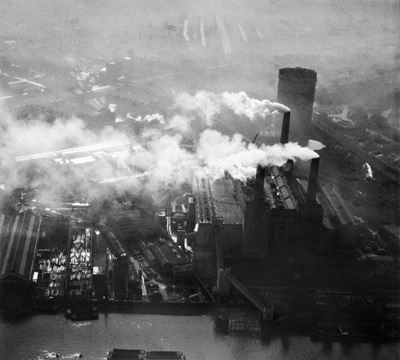
Battersea
Smoke billowing from a darkened Battersea Power Station, Battersea, 1952
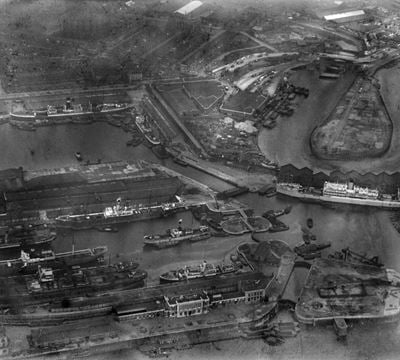
Blackwall
East India Docks, Blackwall, 1921

Blackwall
Brunswick Wharf (Blackwall) Power Station, East India Docks and environs, Blackwall, 1953

St James
The Palace of Westminster, the River Thames and the surrounding city, Westminster, 1939
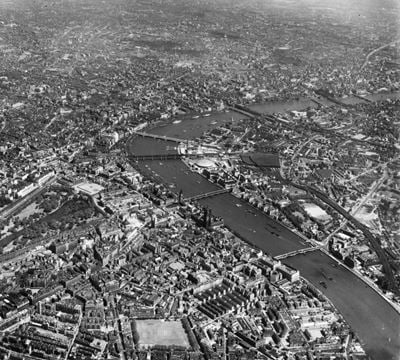
Westminster
The River Thames running through central London, Westminster, 1951
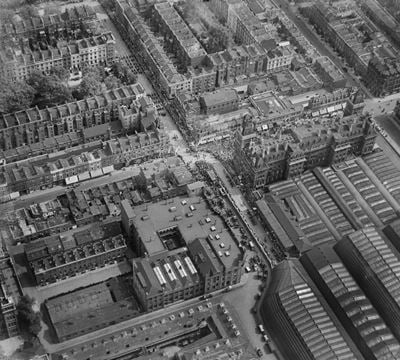
Paddington
Paddington, the homecoming parade of the Prince of Wales, 1922
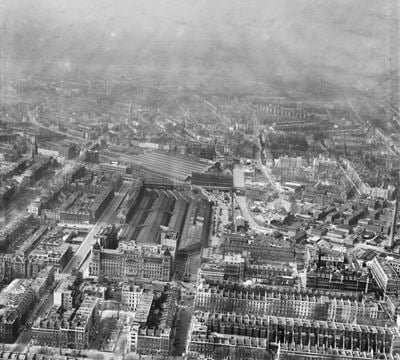
Paddington
Paddington Railway Station and environs, Paddington, 1950
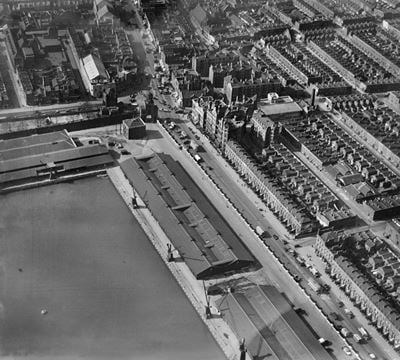
Poplar
Poplar Hospital, East India Dock Road and the North Quay of East India Import Dock, Poplar, 1935
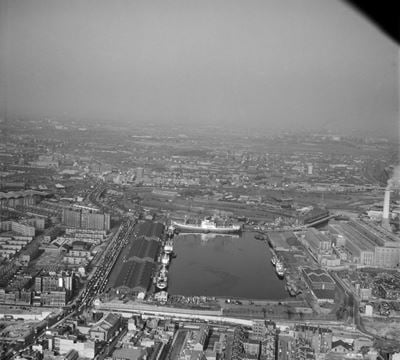
Isle Of Dogs
East India Dock, London, viewed, 1962
Greater London in the Historic England Archive
The Historic England Archive cares for over 15 million images, dating from the 1850s to the present day. Discover stunning images of Greater London's past. Skip this section and go to stories about heritage
Charles George Harper Collection
East Molesey, Richmond Upon Thames, Greater London Authority
Date created: 1892 - 1933
The Great Gatehouse at Hampton Court Palace, showing the ten heraldic statues, known as the King's Beasts, on the bridge over the moat
Eric de Mare
East Molesey, Richmond Upon Thames, Greater London Authority
Date created: 1945 - 1980
Exterior view of Hampton Court Palace showing a Roman statue on a wall.
John Gay Collection: Railway Stations
Marylebone, City Of Westminster, Greater London Authority
Date created: 1960 - 1972
A view looking west along Marylebone Road in Westminster from outside Berkeley Court towards the Old Great Central Hotel in Marylebone
John Gay Collection: London
East Molesey, Richmond Upon Thames, Greater London Authority
Date created: 1961
A young boy hanging on the railings edging the canal to the east of the gardens of Hampton Court Palace
John Gay Collection: Highgate and Hampstead
Kingston Upon Thames, Greater London Authority
Date created: 1966 - 1975
A detail view showing the curved steps leading from the driveway to the entrance to Weeton, 2 The Drive in Kingston upon Thames
John Gay Collection: Modern Architects
Kingston Upon Thames, Greater London Authority
Date created: 1966 - 1975
A view of the driveway, garage and front elevation of Weeton, 2 The Drive in Kingston upon Thames.
John Gay Collection: Rural Life
City Of Westminster, Greater London Authority
Date created: Sep 1980
A view of a case containing two minature long barrelled guns made by James Purdey and Sons of London
John Gay Collection: Miscellaneous
Kew, Richmond Upon Thames, Greater London Authority
Date created: 1946 - 1999
Tulips
John Gay Collection: Counties
Hillingdon, Greater London Authority
Date created: 1959 - 1963
The interior roof of an aircraft hangar at Heathrow Airport with the top half of a Bentley motor car in the foreground
John Laing Collection
Kingston Upon Thames, Greater London Authority
Date created: 30 Nov 1983
The first floor foyer of Kingfisher Leisure Centre, with large plants in pots in the foreground
London, Midland and Scottish Railway Company
Richmond Upon Thames, Greater London Authority
Date created: Jul 1890
Two men standing on the bank of the River Thames, with the Richmond Railway Bridge behind
Nigel Temple Collection of Postcards of Parks and Gardens
Surbiton, Kingston Upon Thames, Greater London Authority
Date created: 1910 - 1940
GENERAL VIEW
Stories about heritage in your local area
Historic England publishes news, blogs, research, videos, and podcasts celebrating England's rich heritage. Discover the stories we have about Greater London. Skip this section and go to education
Remains of London’s Roman Forum Unearthed – Plans for Preservation Shared
Mentions Greater London
Remains of London’s Roman Forum have been unearthed at 85 Gracechurch Street in the City of London.
New Roof and Repairs for Medieval Upminster Tithe Barn
Mentions Medieval grange barn, 228m south-east of Upminster Court, Upminster Hall, Greater London
A 12 month project is underway to save the 15th century Upminster Tithe Barn in partnership with National Highways and the London Borough of Havering.
A Brief Introduction to Semi-Detached Housing
Mentions Numbers 1 to 14 (Consecutive) The Paragon, and Paragon Cottage and Paragon Lodge, Numbers 2-16, 22-34, 36A and 36B and Attached Railings, Lloyd House and Attached Railings
Semi-detached housing is the most prevalent type of housing in England today, making up one third of the housing stock.
How We Built Suburbia: The Development of England’s Suburbs
Mentions 3 and 5, Porchester Terrace W2
Over the past 2 centuries, England’s towns and cities have experienced unparalleled growth, which has led to the creation of the suburbs.
What Was the Capital of England Before London?
Mentions Tower Bridge (That Part in London Borough of Tower Hamlets), Westminster Abbey (The Collegiate Church of St Peter)
London is England’s capital city now, but when was it founded? And what was the capital of England before London?
Groundbreaking English Women of Science
Mentions The Learned Societies, Forecourt Buildings to Burlington House, Elizabeth Garrett Anderson Hospital
Discover the lives of women who impacted scientific discoveries in England's history, such as Marie Stopes and codebreaker Joan Clarke.
A History of Reading in 6 Places
Mentions Natural History Museum, Front Lodge and Gates, Gatepiers and Railings
Reading is the largest town in the UK. Discover the history of the town through its sites such as the Abbey Ruins, Reading Goal and Market Place.
10 Lesser Known Places Linked to King Henry VIII
Mentions Hampton Court Palace, Westminster Abbey (The Collegiate Church of St Peter), Greenwich Palace
Discover the lesser-known historic sites linked to Henry VIII, including Whitehall Palace, Windsor Castle, Rievaulx Abbey, and Eltham Palace, London.
6 Places Connected to Queer Jewish History in London
Mentions Hyde Park, Numbers 25-29 and Attached Railings and Lamp Holder
Discover the places connected to queer Jewish history in London including Hyde Park, Gateways Club in Chelsea, and the Colony Room Club.
What Is the Oldest Castle in England?
Mentions The White Tower
Discover the oldest English castle contenders, including the Norman Berkhamsted Castle, Windsor Castle, Dover Castle and The White Tower, London.
Photographing the First World War on the Home Front
Mentions Clement House, Victoria Embankment Gardens
Life changed on the home front in England during the First World War. This photography collection provides a glimpse into what it was like.
English High Street Architecture Through the Ages
Mentions 34, Haymarket SW1, Barclays Bank, 20 The Town, Enfield, Arding and Hobbs Store
Explore how the architecture of the English high street has evolved over the centuries.
The Life and Works of Visionary Engineer Isambard Kingdom Brunel
Mentions Thames Tunnel, Paddington Station Including the Lawn, Gwr Office Block on London Street and Offices Along Eastbourne Terrace, Statue of IK Brunel
Discover the bridges, structures and ships that Isambard Kingdom Brunel designed, including the Great Western Railway and Clifton Suspension Bridge.
12 Places Connected to Queen Elizabeth I
Mentions Royal Naval College north east building, Queen Anne's Quarter, The Charterhouse, Hampton Court Palace
Discover the locations where Queen Elizabeth I lived and visited, including Hampton Court Palace, Hatfield House and Kenilworth Castle.
Value of Heritage-led Regeneration for England’s High Streets Revealed by New Independent Evaluation
Mentions Greater London
Led by Historic England, the High Street Heritage Action Zone programme unlocked the potential of 67 historic high streets across England.
Remains of London’s Roman Forum Unearthed – Plans for Preservation Shared
Mentions Greater London
Remains of London’s Roman Forum have been unearthed at 85 Gracechurch Street in the City of London.
New Roof and Repairs for Medieval Upminster Tithe Barn
Mentions Medieval grange barn, 228m south-east of Upminster Court, Upminster Hall, Greater London
A 12 month project is underway to save the 15th century Upminster Tithe Barn in partnership with National Highways and the London Borough of Havering.
Archaeological Sensitivity Mapping
Mentions Greater London
Developing a methodology for understanding where future significant archaeological discoveries may be made.
Sustaining London's Vibrant Historic Places
Mentions Greater London
Helping London’s historic character inform future localities through historic urban characterisation projects.
London Archaeology and Characterisation
Mentions Greater London
The challenges of managing change in complex townscapes and time-depth.
Public Access to the Greater London Historic Environment Record Launched
Mentions Greater London
The public now has access to a wealth of knowledge stored in the GLHER, thanks to a collaboration between Getty and Historic England.
Crystal Palace Subway Restoration Revealed
Mentions Subway, Vestibule, Terrace and Stairs to the Crystal Palace, Crystal Palace Park
The remarkable Grade II* listed Crystal Palace Subway in South London begins a new era following major restoration.
London’s Battle of Britain Bunker Still Revealing its Secrets
Mentions Group Operations Room, Greater London
Recent archaeological work at the Battle of Britain Bunker in Uxbridge reveals more about the site, 86 years after it was built.
Research Reports Roundup to February 2024
Mentions Greater London
A roundup of new additions to the Historic England Research Reports database and a longer term overview of industrial heritage reports.
Southend-on-Sea Civic Fountain Listed
Mentions Curzon Mayfair Cinema, Harrods
The Civic Fountain in Southend-on-Sea, Essex, has been listed at Grade II by DCMS on the advice of Historic England.
Praise for Restoration of Former Sanderson Wallpaper Factory
Mentions Voysey House
Historic England has praised the restoration of Voysey House in Chiswick, as Sanderson returns to their former wallpaper factory building.
Greater London's social history through photos
Over 10,000 images from the Historic England Archive have been specially selected and re-captioned for teachers, students, and anyone who wants to learn more about their local area. Skip this section and go to grant-aided places
Zoological Gardens, Regents Park, Westminster, London
Period: Victorian (1837 - 1901)
This stereo view of the Zoological Gardens in Regents Park shows members of the public mounting an elephant for a ride.
Zoological Gardens, Regents Park, Westminster, London
Wright's Almshouses, Hertford Road, Enfield, Greater London
Period: Victorian (1837 - 1901)
This row of almshouses were built in 1847.
Wright's Almshouses, Hertford Road, Enfield, Greater London
Workmen in a canteen during construction at Heathrow Airport, Heathrow, Greater London
Period: 1970s (1970 - 1979)
These workmen are from John Laing plc and were building a new hangar at Heathrow Airport. The men are having a meal and a break in the site canteen.
Workmen in a canteen during construction at Heathrow Airport, Heathrow, Greater London
Workers who built the London Central Mosque with their families at the mosque, Westminster, Greater London Authority
Period: 1970s (1970 - 1979)
There had been attempts to build a new mosque in Central London since 1900.
Workers who built the London Central Mosque with their families at the mosque, Westminster, Greater London Authority
Workers housing, Peabody Estate, Southwark, Greater London
Period: Victorian (1837 - 1901)
This estate of philanthropic housing came before the provision of council housing.
Workers housing, Peabody Estate, Southwark, Greater London
Workers at West India Docks, North Quay, Poplar, London
Period: 1950s (1950 - 1959)
Dock workers handling cargo beside an Hellenic Line ship moored by the dockside.
Workers at West India Docks, North Quay, Poplar, London
Workers at West India Docks, North Quay, Poplar, London
Period: 1950s (1950 - 1959)
A barge is unloaded of her cargo of sugar with the help of a crane and dock workers by the dockside.
Workers Housing, Heath Close, Hendon, Greater London
Period: Edwardian (1902 - 1913)
Waterlow Court was built in 1908-09. It was built for the Improved Industrial Dwellings Company, founded in the 1860s by Sydney Waterlow.
Workers Housing, Heath Close, Hendon, Greater London
Visit grant-aided places near you
These places and buildings have been helped by Historic England's financial grants. Find historic places in your neighbourhood that you never knew existed! Please note that opening times may vary. Skip this section and go to related locations
East and West Stables, Gunnersbury Park
These listed structures within a Grade II* registered park and garden have undergone necessary safety, stabilization, and weatherproofing repairs.
Sphinxes and South Terrace Steps, Upper and Lower Terraces
Victorian sphinxes that formerly guarded the Crystal Palace entrance, one of the few remaining structures after the palace's 1936 fire.
The Dyce Drinking Fountain, Streatham Green
Restored in 2015, the Grade II listed fountain on Streatham Green, designed by William Dyce R.A.
St Stephen, Pond Street
Grade I listed landmark building at the intersection of Rosslyn Hill and Pond Street, constructed in 1869-71 in early French Gothic style.
Severndroog Castle, Shooters Hill
Severndroog Castle, a Grade II* tower in Oxleas Woods, built in 1784 to honor Sir William James.
Discover more
Ready for more local heritage? Take a look at these other places nearby

Lambeth
Local Authority District

Kensington and Chelsea
Local Authority District

Wandsworth
Local Authority District